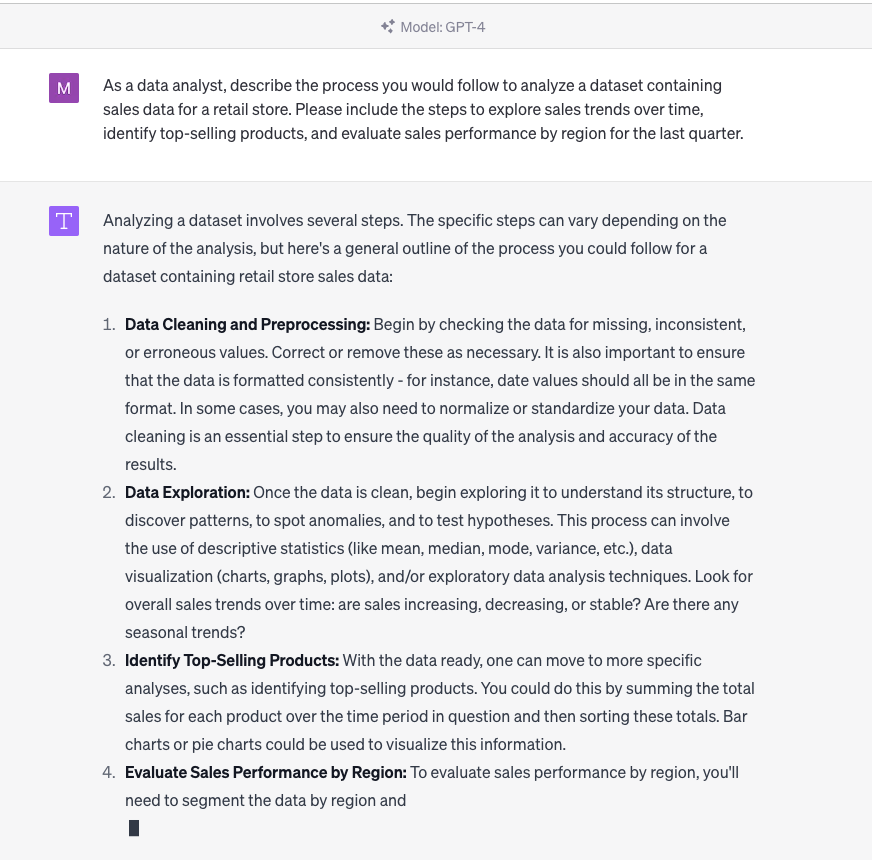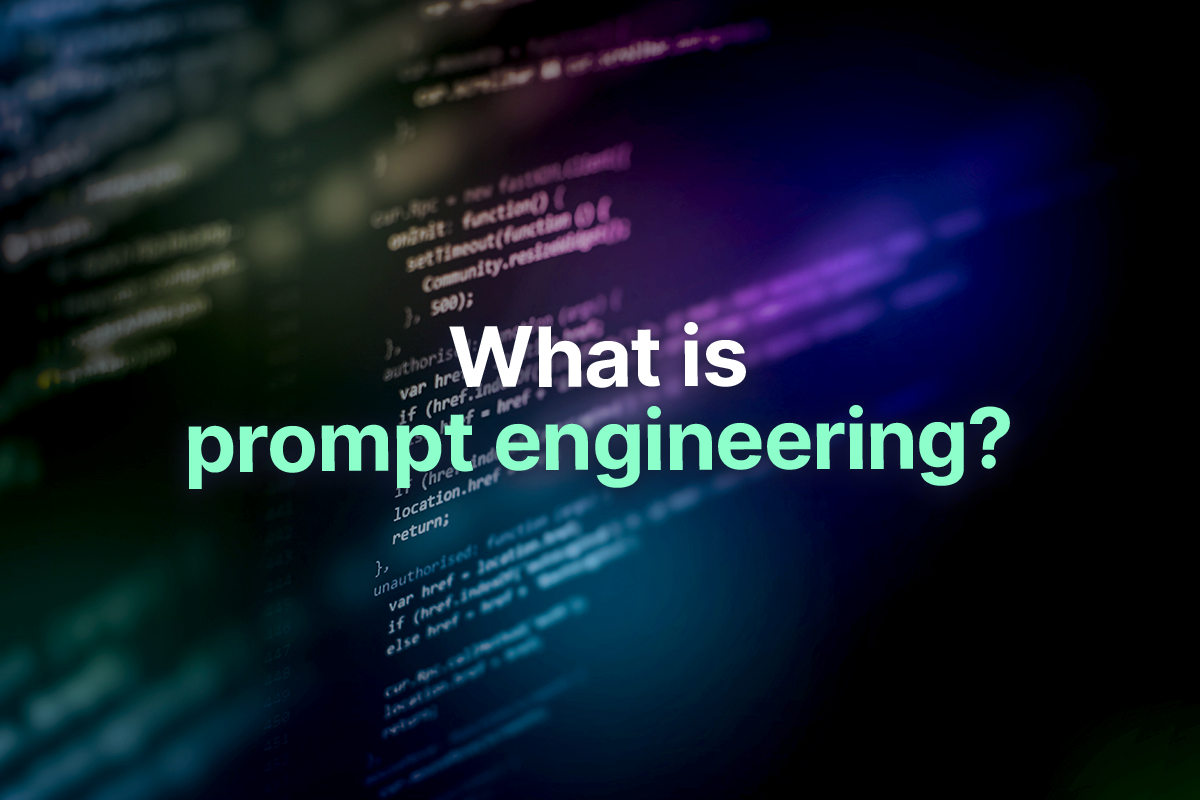ChatGPT, developed by OpenAI, is a powerful tool used for various applications, including chatbots, content generation, and customer service. Its strength lies in generating human-like text based on the prompts it receives. In this tutorial, we will delve into the art and science of Prompt Engineering – crafting precise and effective prompts to get the best responses from ChatGPT.
We decided to focus on ChatGPT Prompt Engineering because it’s a crucial skill when working with language models. Understanding how to create effective prompts leads to more accurate, focused, and useful responses. Check out our course, Introduction to ChatGPT to get up to speed with the basics of the tool.
Understanding ChatGPT
Before we dive into prompt engineering, let’s understand how ChatGPT works. It’s a transformer-based model that utilizes machine learning to produce text. It’s trained on a diverse range of internet text and other resources but doesn’t know specifics about which documents were in its training set.
How ChatGPT works
ChatGPT generates text by predicting the next word in a sentence. It does this multiple times to create complete sentences. For instance, given the input “The sun is…”, it might predict the next word as ‘shining’ or ‘rising.’
Understanding this is key to prompt engineering: you’re essentially guiding the model’s predictions. Read our guide on What is ChatGPT to get a better understanding of how the large language model works.
Foundations of ChatGPT Prompt Engineering
Prompt Engineering is the art of crafting prompts that effectively instruct ChatGPT to generate the desired output. It involves understanding the model’s behavior and tweaking the input to guide the model’s responses.
Starting point
Let’s assume we want GPT-4 to generate a brief data analysis report. We could start with the prompt, “Provide a data analysis report.” While this may yield a reasonable response, we can optimize this further.
A more effective prompt might be:
“As a data analyst, describe the process you would follow to analyze a dataset containing sales data for a retail store. Please include the steps to explore sales trends over time, identify top-selling products, and evaluate sales performance by region for the last quarter.”

ChatGPT prompt engineering at work
This revised prompt is specific; it sets a role (data analyst) and outlines the exact information required, leading to a more effective output. It instructs GPT-4 to not only summarize the dataset but also analyze sales trends, top products, and regional performance, providing a broader scope for the analysis.
Principles of Effective Prompt Engineering
Clarity
The prompt should clearly define what you want the model to do. Avoid ambiguity. For instance, instead of “Tell me about dogs,” use “Provide a detailed description of the characteristics, behavior, and care required for domestic dogs.”
Context
ChatGPT responds to the immediate context of the prompt. So, establishing a clear context is crucial. For example, the prompt “Translate the following English text to French: ‘Hello, how are you?'” provides clear context and instructions.
Precision
Precise prompts yield precise responses. For example, if you want a list, specifically ask for it: “List the top 10 most populous countries in the world.”
Role-play
ChatGPT responds well to role-play. You can set it in a role to guide its responses: “As a historian, explain the significance of the American Civil War.”
How to Write ChatGPT Prompts for Data Science Scenarios
Let’s apply our principles to create prompts for data science scenarios, ensuring that they are clear, contextual, precise, and occasionally involve role-play.
Scenario 1: Data cleaning
Prompt: “As a data scientist, describe the process of cleaning a dataset before it is used for analysis. Include steps such as handling missing data, dealing with outliers, and data normalization.”
This prompt is clear, precise, and provides context. It sets a role for ChatGPT (a data scientist) and specifically asks for steps in data cleaning, ensuring a detailed response.
Scenario 2: Machine learning model explanation
Prompt: “As a machine learning expert, explain the concept of ‘Random Forest’ to a beginner, including its basic principles, advantages, and common use cases.”
Again, we see clarity, precision, and context. The role-play element guides ChatGPT to respond in a certain way. The mention of ‘beginner’ ensures the explanation is simple and easy to understand.
Scenario 3: Data visualization technique
Prompt: “As a data visualization expert, explain the concept and process of creating a ‘Box and Whisker Plot’ in data analysis. Include its purpose and how to interpret it.”
This prompt is effective as it clarifies the expected complexity and specific aspects to cover in the response. It also sets the role for ChatGPT, guiding the depth and tone of the explanation.
Debugging ChatGPT Prompts
Sometimes, even well-crafted prompts might not yield the desired output. In such cases, it’s useful to debug the prompt.
Adjusting the tone and formality
If the output is too formal or casual, you can guide the tone by adding instructions like “Explain it to me like I’m five” or “Write a formal report on…”.
Tweaking the details
If the output is too vague or overly detailed, adjust the prompt accordingly. Add words like “briefly” or “in detail” to guide the response’s length and depth.
Experiment and iterate
Don’t be afraid to experiment and iterate on prompts. Sometimes, slight rephrasing or additional instructions can yield significantly better results.
Final Thoughts
Prompt Engineering is a crucial skill when working with ChatGPT. It requires understanding the model’s behavior and crafting prompts that are clear, contextual, precise, and sometimes, role-based. With practice, you can master the art of prompt engineering and leverage the full potential of ChatGPT.
Remember, the key is to be explicit about what you want the model to do and how you want it to do it. Experiment with different structures and instructions, and learn from the output to improve your prompts.
This tutorial is the beginning of your journey in ChatGPT Prompt Engineering. As you explore further, you’ll discover more techniques and nuances that will help you craft effective prompts for any scenario.
Chat GPT Prompt Engineering FAQs
What is ChatGPT prompt engineering?
ChatGPT prompt engineering refers to the practice of crafting input prompts in specific ways to guide the AI model’s responses. The way a question or statement is phrased can have a significant impact on the information returned by the model.
Why is prompt engineering important?
The quality and relevance of the model’s response often depend on how the prompt is framed. Well-crafted prompts can help guide the model toward providing more accurate and useful responses.
What are some tips for effective ChatGPT prompt engineering?
- Be specific. If the prompt is vague, the model may not provide the desired information. Try to include as much relevant detail as possible.
- Use the right format. If you want the model to generate text in a particular style or format (like a poem or a list), specify this in your prompt.
- Ask for the reasoning. If you want to understand the model’s reasoning or if you want a more detailed response, you can ask the model to explain its answer.
How does ChatGPT handle ambiguous prompts?
ChatGPT tries its best to interpret and respond to ambiguous prompts, but the responses may not always align with the user’s expectations. To get the best results, it’s recommended to make your prompts as clear and specific as possible.
How can I improve the model’s comprehension of my prompts?
Aside from being specific and clear, you can also experiment with different phrasings, provide more context, or ask the model to confirm its understanding of your prompt.
